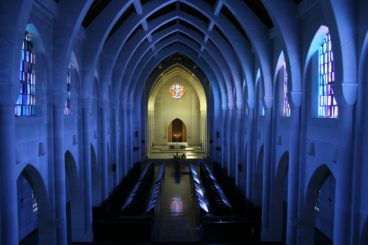
Service starts at 11:00 am at St. John’s Missionary Baptist Church. In eight months, Leah and I have never yet been on time. When we chain our bikes to the handrail on the handicap ramp, I can hear the hum of the electric organ and the pulse of hands clapping. Sister Street and Sister Thomas open both of the double doors, smile wide, and hand us each a bulletin. Everyone is standing. The choir sways left to right and back again on two and four. No need for hymnals; everyone knows the song. Those who don’t can pick it up soon enough and join the saints in praising a God who was good enough to wake us up this morning and give us breath to breathe. I’ll confess, I don’t feel like jumping up and down every Sunday morning. But that doesn’t matter. Rev. Daniels says with determined simplicity, “We’re gonna praise God anyhow.”
At Chapel Hill Mennonite Fellowship, service starts around 6:00 pm. We’re always early. I greet Steve with a smile in the parking lot and wave to Fred and Elizabeth who are just pulling in. Leah, Isaac, and I chat as we walk to the door. Inside, a reverential hush reigns and any speaking is done in whispers. Any serious catching up or making jokes can wait until snack time, immediately following worship. Or maybe I should say, “at the end of worship.” Eating together is, after all, part of what we do together at the Mennonite fellowship. No one would think of leaving right after the benediction.
In the language of our present predicament, Chapel Hill Mennonite is a “white” church; St. John’s is “black.” This is not entirely true, of course. On most Sunday evenings, at least one black person joins us. Sometimes we have a few. At St. John’s Leah and I are usually the only white people present. And we are welcome. Still, it is an almost schizophrenic experience to worship in both congregations every Sunday. As I listen to our language in both communities, it is clear that the worship experiences are so different because they arise out of different stories. Hardly a Sunday goes by at St. John’s without some reference to God’s faithfulness toward African Americans as an oppressed people — and rightly so. God has seen St. John’s through the dark and trying times in this little Southern city. Even now, Jesus still offers hope in the midst of suffering — in a neighborhood where three people have been shot in the past three weeks. To worship at St. John’s is to come face to face with the God who sustains his hurting people. With the Mennonites, I hear a different story. We talk about our middle-class backgrounds and our over-educated demographic. We assume responsibility for many of the troubles of this world and worry about how to live differently. We talk a lot about “alternatives,” and we find Jesus offering us a “new Way.” We feel guilty, but we’re hopeful, too.
It is an almost schizophrenic experience to worship in both congregations every Sunday.
Neither of these two stories fails to recognize its interaction with the other. St. John’s knows it has been wronged by white America. Chapel Hill Mennonite knows it has benefited from and participated in that abuse. Both stories see problems; both have the same answer: Jesus. Worshiping him between these two stories, I’m learning to see Jesus anew. He is the answer to my white, middle-class problems, and he is also the hope for my brothers and sisters at St. John’s. What’s more, he has made our stories one in the new creation of his kingdom. In Jesus, we are confronted with a new humanity, not divided by ethnic ties but restored to the original unity of one body (only this time the body is not called “Adam” but “church”). The reconciliation that is a reality in Christ’s church is not a denial of the two stories we live each Sunday. Rather it is a confession of them. When we tell the truth about our history, we step into a relationship where forgiveness is possible. Reconciliation begins wherever we are able to tell the truth.
If we’re honest, both blacks and whites in America have to confess that there is a problem with the segregated Sabbath. My friend Chris Rice reminds me that on any given Sunday in America, 95% of whites worship in “white” churches and 95% of blacks worship in “black” churches. “The worst part is, this doesn’t bother us,” Chris says. It doesn’t bother us because we don’t know what we’re missing. The white church fails to recognize that freedom from its own slavery means confessing to the black church that we have sinned against it. Likewise, the black church does not always see that it cannot be truly emancipated until it has forgiven the white oppressors. What we must all see — black and white together — is that we are not living “in Christ” until we live and worship as the new humanity, reconciled by the forgiveness that only God makes possible.
It is not the case, however, that the good news of reconciliation is not true until we live it. “New creation” is a reality because of what God has already done in the death and resurrection of Jesus Christ. We are not called to “build God’s kingdom here on earth.” It is here, bursting forth in the vibrant thanksgiving of Negro spirituals and the loving community of Mennonite witness. It is here and it is coming in the new work that God is doing. The good news is that God invites us to participate in his new humanity — to practice resurrection in truth-telling and forgiveness. Accepting the invitation may often look like death, opening old wounds, and risking new ones. It is not safe. But we who know Jesus know the logic of the cross. Only in dying are we born to eternal life.
For a white guy who grew up in the Southern Baptist church, the truth is not always pretty.
During black history month, St. John’s put on a play retelling their story of tribal betrayal and the middle-passage; life on the plantation and the Underground Railroad. In the course of an hour and a half, I played all the white parts: slave-trader, “mass’uh,” emancipator, and civil-rights activist. As we remembered black history, I was forced to remember my own. For a white guy who grew up in the Southern Baptist church, the truth is not always pretty. Since that play, however, the folks at St. John’s have taken to calling me “Abe,” as in Abraham Lincoln. I count it as an extension of forgiveness. My brothers and sisters at St. John’s have chosen to remember the best of my people’s history every time they look at me. To them, I am a representative of the emancipators, not the oppressors. In Christ, I have been forgiven.
God alone knows what the reconciled church looks like. But God does not call us to build it. How would we know where to start? Instead, God wants to build a house for us — to make us beloved children in his family. As baptism reminds us, we get born into this family by dying. It is God who raises black and white together into the multi-ethnic humanity of his beloved Son.
Jonathan Wilson-Hartgrove and his wife Leah founded the Rutba House, a house of hospitality where the formerly homeless are welcomed into a community that eats, prays, and shares life together.


